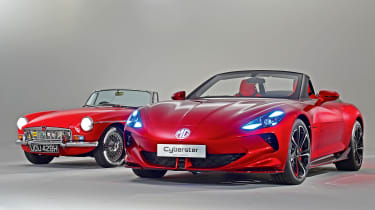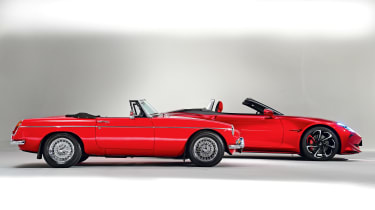Past meets future as a classic MG lines up with the brand’s reimagined roadster
How do you reimagine the classic British sports car for the electrified age? That’s the question that Carl Gotham and his team at MG’s advanced design studio had to answer. To quantify how the new Cyberster fits into MG’s varied heritage, we’ve brought along perhaps the single model most synonymous with the brand: the MGB Roadster. Why? To see how the two models relate to one another, and discover which elements define, not just MGs, but the ‘great British sports car’.
The first and perhaps most fundamental visual reference are the proportions. The MGB was defined, like many sports cars of the era, by its front-engined rear-drive layout, with an in-line engine mounted longitudinally, or lengthways, under the bonnet. Connected to this was a manual transmission that fed power through to the rear wheels. This gave the MGB and its contemporaries their typical long bonnet, with a compact two or two-plus-two cockpit located behind, closer to the rear axle.
New 2023 MG Cyberster: performance, pricing, and release date
From a dynamic point of view, this was ideal to help balance the chassis, and put as many of the car’s heavy elements, such as the powertrain, as close to the centre as possible. But another and even more important proportion this layout dictates is what’s called the dash-to-axle ratio, or the space between the windscreen (and the bulkhead underneath it) and the front wheels. This ratio, as with traditional luxury saloons or GT sports cars, was also particularly generous and one of the foundations of the classic British sports car.
Modern open-top sports cars, such as the Mazda MX-5, also adhere to this layout, and it’s something the Cyberster also features, despite having a completely different set of technical elements beneath it. Carl Gotham, the man in charge of the Cyberster’s design, says: “The biggest challenge, as with any project like this, was to keep the essence and the spirit of the original idea. The windscreen position was key to the proportions we were trying to achieve.”
With the cars side by side, it’s clear that they share these fundamental aspects; the Cyberster’s bonnet is long, the cockpit compact and that all-important dash-to-axle ratio is just as generous. Yet from here it’s clear that Gotham and his team have taken a more ideological path in reimagining the surfacing and detailing. In contrast to retro-pastiche designs such as the modern MINI or Fiat 500, the Cyberster’s direction is firmly future-facing, as Gotham notes: “The balance is to pay respect to the past, but to also look forward.”
But there is perhaps one proverbial elephant in the room, and that’s the Cyberster’s size. The last defining factor of the British sports car is a petite footprint, perfect for traversing the UK’s narrow B-roads.
Yet the reality of electrification, and the fact most of the mechanical elements have to be shared with more mainstream MG models for the sake of economies of scale, mean the Cyberster is a substantially bigger car than we expected. One look at it beside the compact MGB shows by how much. But will this actually matter to customers? We suspect not.
Click here for our list of the 25 coolest cars in the world…
Source: Read Full Article



 New 2023 MG Cyberster: performance, pricing, and release date
New 2023 MG Cyberster: performance, pricing, and release date